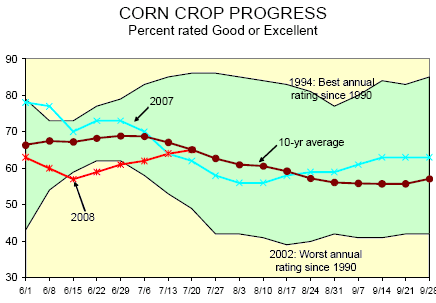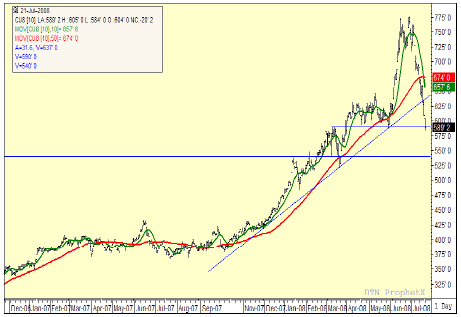



CME: Improvement in Corn and Soybean Conditions
US - CME's Daily Livestock Report for 21 July 2008.The developments of the past two weeks in the grain and oilseed markets are the best news received by livestock feeders in some time — and the hit parade rolled on with another increase in crop conditions and another technical barrier broken in September corn futures.
| E-Livestock Volume | 7/21/08 | 7/18/08 | 7/14/08 |
|---|---|---|---|
| LE (E-Live Cattle): | 7,990 | 10,702 | 20,873 |
| GF (E-Feeder Cattle): | 1,167 | 1,166 | 895 |
| HE (E-Lean Hogs): | 13,882 | 13,833 | 19,053 |
USDA's weekly Crop Progress report indicates that the conditions of both the corn and soybean crops continued to improve last week. The data for corn is presented in the top chart at right. The percentage of the crop in good or excellent condition continued to climb — this week to 65%. That is 1% higher than last year, 3% higher than last week and roughly even with the 10-year average for this week. Warm days and nights have kept the crop improving steadily and widespread rains across the Midwest this weekend will, at least in most areas, provide enough moisture to get us through the critical pollination stage. The crop is still susceptible to heat (especially during pollination) and is still behind from a maturity standpoint. Only 34% of acres were silking as of Sunday compared to a 5-year average of 60%. An early frost would still be quite damaging.
A very non-scientific “windshield” survey of corn from central Iowa to central Illinois and all the way back across Missouri to Kansas City last Tuesday and Wednesday confirmed most of what we had heard about crop conditions. Parts of Iowa look very good while most still looks quite uneven and bottom ground is primarily planted to soybeans. Western Illinois looks 'excellent' with even stands of tall corn that was pretty much fully tasselled. Missouri looked quite uneven as well with bottom ground looking very bad (if it was still even in corn) and upland being somewhat uneven. Still, everyone is talking about how much the crop has improved in the past few weeks.
And the results are predictable — the largest 3-week break in corn prices since July 1996! We noted last Monday that September corn had broken through the 50-day average. It then penetrated a long-term uptrending support line at $6.34 on Thursday and today broke a minor support line at $5.90. The price of September corn has fallen $2.14/bushel (27.6%) since June 27. All of the new-crop corn futures charts look virtually the same as this one though prices for other contracts have not penetrated their support lines in the $6.00 range — YET.
Though slow to the party, soybean meal prices have jumped on the downward slide as well with contracts down $50 to $70/ton since peaking on July 11. Perhaps more noteworthy, EVERY soybean meal contract on the board penetrated its 50-day moving average in today’s trading.
How important are these reductions? These declines have reduced hog feed costs by $45-$50 per ton through next July and $30-$40 per ton from August through October 2009. Those feed cost declines have taken roughly $10/cwt carcass off the breakeven costs of hogs next summer, leaving that magic number at about $86 — lower than any LH futures contract from April 2009 forward.










